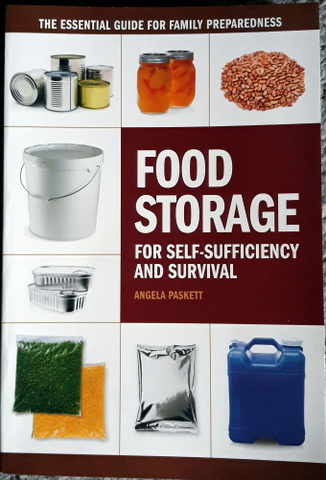Storing food appropriately can be important to make the most of home grown fruit and veg as well as improving your resilience in case of occasions where access to food is restricted. This may be personal issues like sickness or retrenchment, or wider scale supply chain problems caused by floods, fires or a pandemic. The following books will give you some ideas!
How to Store Your Garden Produce – Piers Warren – Green Books (UK) 2008 ISBN 978 1 900322 17 1 – This first part of this book discusses the techniques of preserving fruit and vegetables including clamping, freezing, drying, vacuum packing, salting, bottling, jams etc., fruit butters and cheeses and fermenting. The second part of the book covers each type of produce and how the basic techniques apply to it. A small book with some colour photos in the middle, and lots of good info.
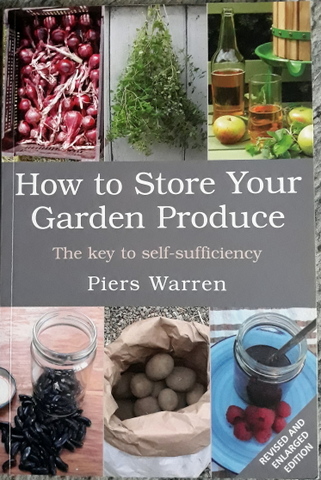
How to Store Your Home Grown Produce – John and Val Harrison – Right Way Publishing (UK) 2010 ISBN 978 0 7160 2246 6 – This book has twenty small (4 to 10 pages) chapters, starting out with health and safety, then moving on to how food ripens and rots, followed by where to store and natural storage. The book then moves on to salting, lacto-fermentation, bottling, then chutneys, ketchups, sauces and pickles. This is followed by jams, juicing cider and perry, drying, storing in oil, freezing, vegetables, fruits, herbs, eggs and conversion charts. The book has quite a few colour pictures and some line drawing. The book has a small amount of information on a lot of subjects.

Root Cellaring – Mike and Nancy Bubel – Storey Publishing (US) 1991 ISBN 978 0 88266 703 4 – The book has good B&W photos and line drawings. It starts off with growing and harvesting vegetables for root cellaring, then covers treating fruits and vegetables before storage. The book also has a large section on the DIY root cellar and some ideas are translatable to the urban and suburban environment. This is a good book and worth getting if root cellars are your bag.
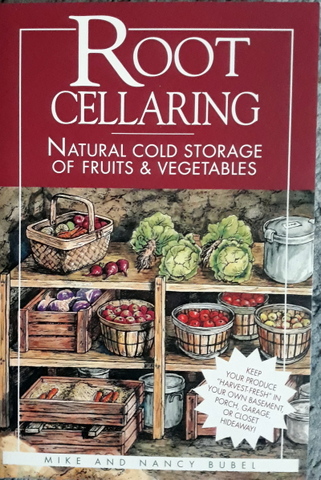
The joy of Keeping a Root Cellar – Jennifer Megyesi – Skyhorse Publishing (US) 2010 ISBN 978 1 60239 975 4 – Regardless of the title, this book also covers drying, canning, picking and freezing for food storage, with preservation of meat, dairy and eggs also being covered. All told only about 20% of the book actually covers root cellaring. There are lots of colour photos which gives this book a “coffee table book” feel and reduces the amount of information presented although there is still some good info.
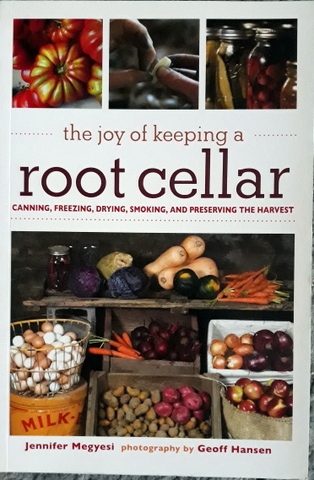
Passport to Survival – Esther Dickie – Bookcraft Publishers (US) 1969 ISBN 978 0 39449 228 5 – This is THE original book on the survival Four foods (wheat, sugar/honey, powdered milk, salt), the idea being that this is the most cost effective, storable diet that can be salted away in case of hard times. It gives lots of recipes for the survival four in various combinations, and some are pretty out-there! The book is divided into four parts, the first part is an introduction cover why they might be necessary, introducing the survival four foods, also other foods that can be included in a storage program and how the diet works. Part two provides a whole stack of recipes based on the survival four. Part three covers other techniques like food preservation and storage, water and other necessities and outdoor survival. Part four covers other options for the future. The book has a small section of colour plates at the centre and there are a few B&W photos scattered throughout.
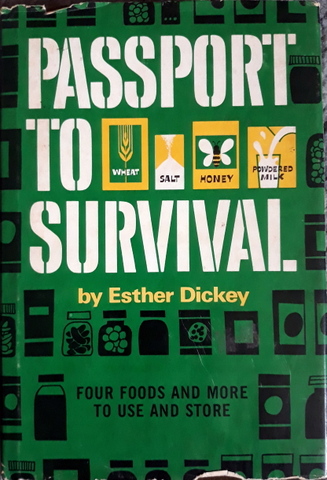
The New Home Larder – Judith Wills – Transworld Publishers (UK) 2009 ISBN 978 1 905 81131 1 – (Larder = pantry = store cupboard) As the blurb on the back of the book says about setting up a larder – “….You’ll have everything you need to make delicious and nutritious meals without shopping for items everyday”. The book has three parts, part one is ‘Your Larder’ which provides information on setting up your own home larder including why it is important, detail on setting it up and practicalities of operating a larder including cleaning and clearing, avoiding and treating larder pests and making the most of space. Section two, almost half the book, provides a series of recipes based on the stores in your larder including easy suppers, salads and side dishes, preserves and preserving, baked goods and festive occasions. Part three is entitled ‘resources’ and gives a detailed paragraph on all of the larder staples and where you can get them (UK Based). The book has lots of colour photos.
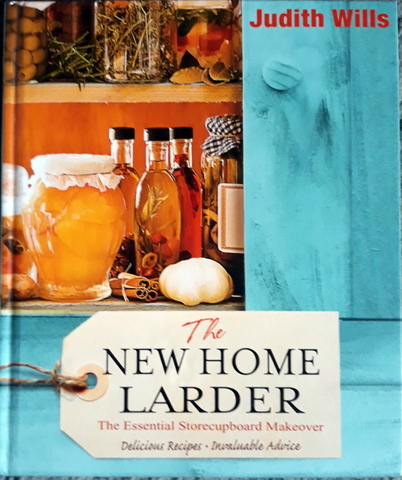
Independence Days – Sharon Astyk – New Society Publishers (US) 2009 ISBN 978 0 86571 652 0 – I love Sharon Astyk’s stuff! The book has seventeen chapter in two parts, and each chapter has a number of recipes associated with it at the end of the chapter. Part one is ‘Independence Days’, the first chapter covering the problem and why we should prepare for hard times; chapter two talks about making the most of what we have – Local Eating, Pantry Eating; Chapter three covers how much food you should store. Chapter five talks about food storage on the cheap and chapter six talks about eating from your food storage – every day. Part two covers food storage and preservation how-to. Chapter six covers the mechanics of food storage and chapter seven covers energy conscious food preservation, Chapter eight covers root cellaring and season extension. Chapters nine, ten and eleven cover dehydration, canning (bottling) and fermentation respectively. Chapter thirteen covers cooking when the power is out, chapter fourteen covers medicines, health care and special diets, chapter fifteen talks about managing your food storage and chapter sixteen covers sreating and using community resources. Chapter seventeen covers bring it all together. There are no lin drawings or photos in the book, text only.
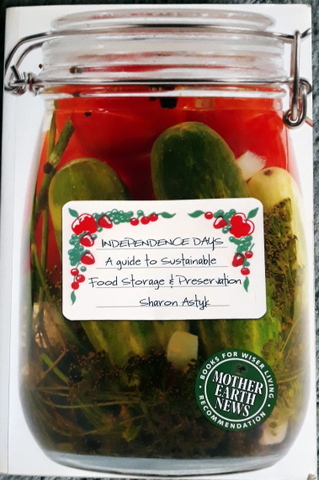
Cooking with Stored Foods – Carlene Tejada & Caroll Latham – H. P. Books (US) 1981 ISBN 0 89586 120 8 – While this is primarily a recipe book, there is a section at the start covering why food storage is a good idea, rotating foods, store-a-meal, electricity power outage and storing water for emergencies. The rest of the book (130 pages) are a series of recipes (over 200 recipes) grouped around meals (breakfast, appetisers, desserts) or ingredients (vegetables, meats, wheat, breads, soups, wheat, chicken & fish). Most of which you can get from your garden, store cupboard or food storage area. On a quick look through there were not too many weird ingredients but a couple like ‘butter flavour granules’ or ‘sweet pickle juice’ you might have to look a bit hard for. The book has lots of colour photos.
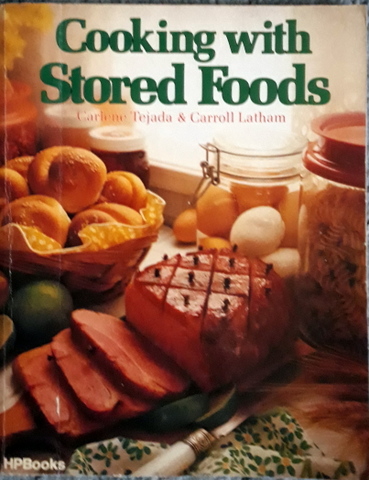
Healthy Food Storage Guide Book – Karen Lee – Sun Bounty LLC (US) 2013 ISBN 978 0 615 91696 5 – The book is composed of two sections, section one is entitled ‘Healthy Eating for Tough Times’ and takes up about a quarter of the book. It has some ‘interesting’ ideas. The second part of the (the bit I am interested in) is entitled The Healthy Food Storage Guidebook. Chapter one covers 12 reasons why you should store food, Chapter two, twenty food storage mistakes and tips and chapter three details how to start a feed storage program. Chapter Four covers water storage, Chapter five grains (and potatoes for some reason!), Chapter six legumes, chapter seven milk and dairy, chapter eight canned goods, Chapter nine freeze dried and dehydrated foods. Chapter ten sweeteners and chapter eleven oils. Chapter twelve covers storing in buckets, chapter thirteen grain mills, chapter fourteen stoves, heaters and cooking and chapter fifteen covers water filters and cleaning items. The book has the odd B&W photo.
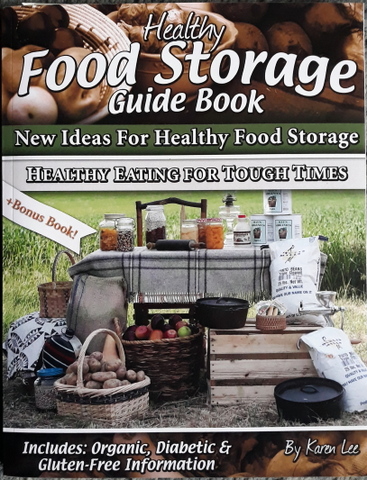
Food Storage (for self sufficiency and survival) – Angela Paskett – Penguin/Random House (US) 2014 ISBN 978 1 4403 3353 8 – While this a comparatively small book, it does have a lot of information. Chapter one covers constructing a ’72 Hour Survival Kit’, essential if you need to relocate rapidly due to flood, fire or whatever. Chapter two covers foods for short term emergencies, ie two weeks to three months and Chapter three covers food storage for longer emergencies, three months or longer. Chapter four covers storing water, chapter five covers food preserving by canning and dehydrating, chapter six covers how to package your storage food for long term storage to exclude pests, moisture, oxygen etc. Chapter seven cover buying food for your food storage program including budgeted purchases and bulk buying. Chapter Eight covers how to maintain balance and variety to avoid menu fatigue and chapter nine covers supplementing your food storage by growing food, raising animals and/or hunting (a rough overview of complex subjects in 20 pages). Chapter ten covers organising your food storage and chapter eleven covers using it. There are fifteen appendices at the end of the book with useful forms, storage lists and resources. The book has a few black and white photos.
